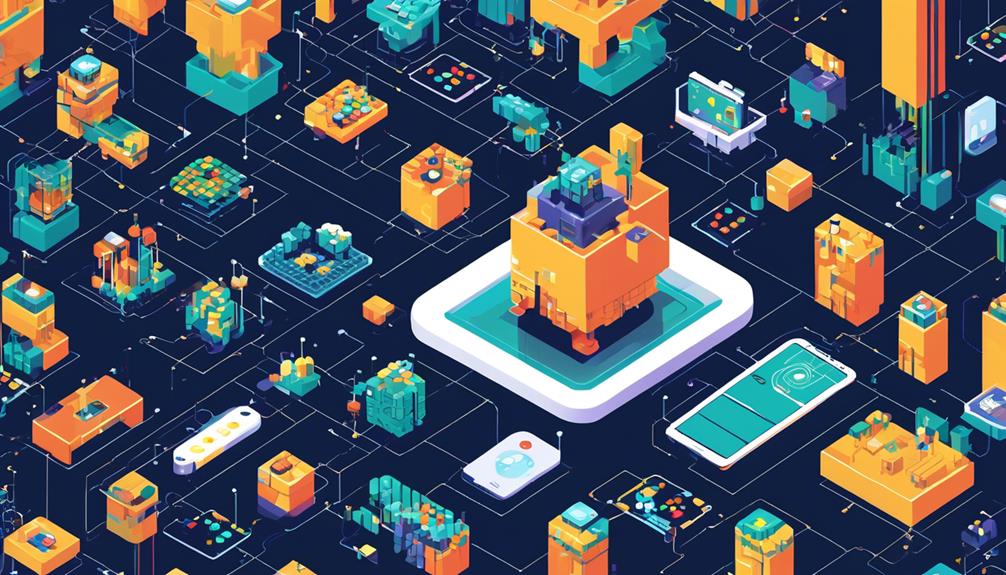The rapid advancement of technology has paved the way for the Internet of Things (IoT) to become an integral part of our lives. IoT devices, with their ability to connect and communicate with each other, have revolutionized various industries and enhanced our daily experiences.
To understand the key components that make up these devices, we need to delve into the intricacies of their design and functionality. From sensors that capture data from the physical world to actuators that enable actions based on that data, IoT devices rely on a multitude of components working seamlessly together.
Additionally, connectivity modules, controllers, data processing units, firmware and software, cloud infrastructure, user interfaces, and integration capabilities all play crucial roles in enabling the efficient operation of IoT devices.
In this discussion, we will explore each of these components, their importance, and how they contribute to the overall functionality of IoT devices.
Key Takeaways
- Sensors and actuators are essential components of IoT devices, as they collect data from the environment and execute physical actions based on that data.
- Connectivity modules and integrated antenna design enable wireless communication options for IoT devices, enhancing their ability to connect and interact with other devices and systems.
- Data processing units and software applications play a crucial role in analyzing and extracting relevant information from the collected data, allowing for intelligent decision-making and higher-level functionality.
- Security mechanisms, authentication protocols, and cloud infrastructure are necessary components to ensure the privacy, integrity, and accessibility of IoT data, as well as protection against cyber threats.
Sensors
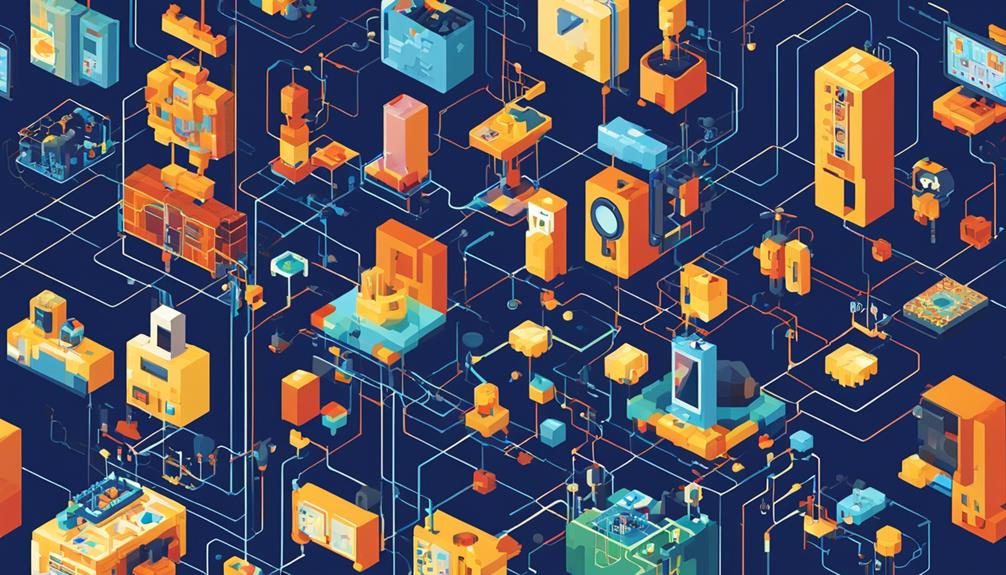
Sensors are integral components of IoT devices, responsible for collecting precise and diverse data from the environment, including temperature, light, sound, and pressure. These devices play a crucial role in data collection and action execution in IoT systems. By continuously monitoring the environment, sensors enable IoT devices to interact with and respond to their surroundings.
One of the key functions of sensors is to collect data. They are designed to capture specific types of information, such as temperature, light intensity, sound levels, and pressure variations. This data is then transmitted to a central location for further processing and analysis. Sensors are able to provide accurate and real-time data, which is crucial for making timely decisions and taking appropriate actions.
Data processing is a critical step in utilizing the information collected by sensors. The collected data needs to be analyzed, interpreted, and transformed into meaningful insights. This process involves filtering out noise, identifying patterns, and extracting relevant information. Furthermore, data processing may also involve applying algorithms and statistical techniques to uncover hidden relationships and trends within the data.
Sensors are designed to be highly sensitive and accurate, ensuring the reliability of the collected data. They are often calibrated to provide precise measurements, which is essential for various IoT applications. Additionally, sensors can be integrated with other components, such as actuators, to enable automated actions based on the collected data.
Actuators
Actuators play a pivotal role in the IoT ecosystem by translating digital data into physical actions, enabling IoT devices to interact with and impact the surrounding environment. Here are three key points about actuators in IoT devices and systems:
- Execution of Physical Actions: Actuators are devices that carry out physical actions based on the data collected by sensors in an IoT system. These actions can include opening or closing valves, turning on or off switches, adjusting motor speeds, or controlling other mechanical or electrical operations. By executing these actions, actuators enable IoT devices to have a tangible effect on the physical world.
- Bridging the Gap: Actuators play a crucial role in bridging the gap between digital data and physical world responses in the IoT ecosystem. They enable the translation of data into meaningful actions, allowing IoT devices to interact with the environment and respond in real-time. This responsiveness is key for creating dynamic and interactive functionality in IoT systems.
- Essential Component: Actuators, in conjunction with sensors, form a vital component of IoT systems, enabling real-time data-driven actions and control. While sensors collect data from the environment, actuators act upon that data, creating a closed-loop feedback system. This feedback loop allows for continuous monitoring, analysis, and response, resulting in enhanced automation, efficiency, and functionality in IoT devices and systems.
Connectivity Modules
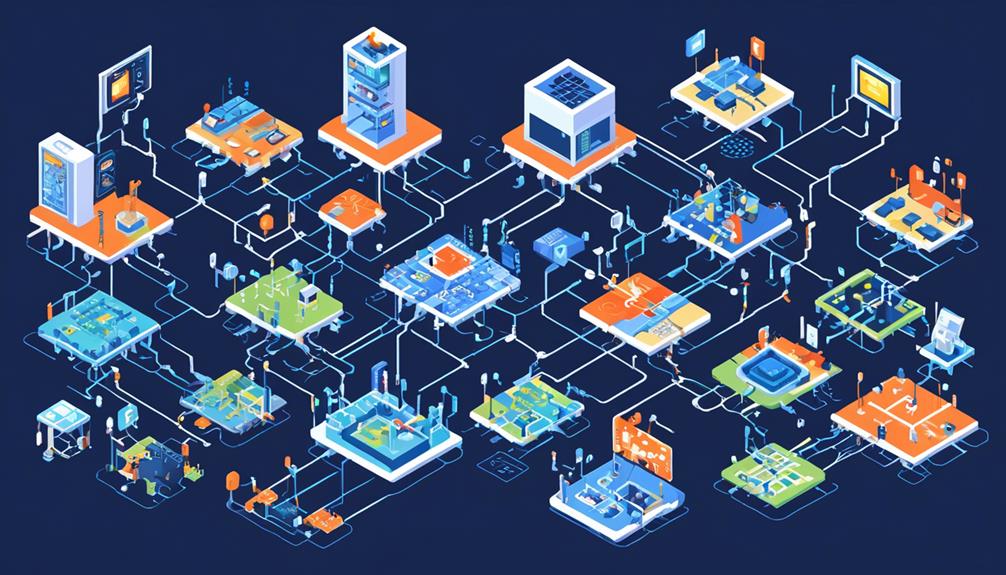
Connectivity modules play a vital role in enabling wireless communication options for IoT devices. These modules support various IoT connectivity standards, ensuring seamless integration and interoperability.
Integrated antenna design is another crucial aspect of connectivity modules, as it improves signal transmission and reception, enhancing the overall performance of IoT devices.
Wireless Communication Options
Wireless communication options, also referred to as connectivity modules, play a pivotal role in facilitating seamless interaction and data transmission between IoT devices and the central location. Here are three key wireless communication options commonly used in IoT devices:
- WiFi: WiFi is a widely adopted connectivity option that provides high-speed data transfer over short to medium distances. It allows IoT devices to connect to local networks and transmit data to the cloud or data storage location.
- Bluetooth: Bluetooth is commonly used for short-range communication between IoT devices and mobile devices or gateways. It is energy-efficient and ideal for applications where power consumption is a concern.
- Cellular: Cellular connectivity enables IoT devices to connect to cellular networks, providing wide coverage and reliable communication. It is suitable for applications that require long-range communication and continuous connectivity.
The choice of wireless communication option depends on factors such as power consumption, range, and bandwidth specific to the IoT application. These options enable seamless data transmission, allowing IoT devices to interact with the environment and transmit data for processing and analysis.
Iot Connectivity Standards
Iot Connectivity Standards, also referred to as Connectivity Modules, encompass various technologies and protocols used to establish internet connections for IoT devices. These standards include WiFi, Bluetooth, cellular, satellite, LPWAN, and ethernet, enabling the transmission of data to the cloud or central location.
The choice of connectivity standard depends on factors such as power consumption, range, bandwidth, and specific IoT application requirements.
Connectivity modules play a crucial role in facilitating seamless communication between IoT devices and the central location, enabling real-time data analysis and decision-making. They are essential components of IoT systems, ensuring effective transmission and reception of collected data.
Integrated Antenna Design
The optimization of wireless communication within IoT devices involves integrating antennas into their design, ensuring reliable connectivity and efficient data transmission. Here are three key components of integrated antenna design:
- Space Optimization: Integrated antenna design allows for the efficient use of space within IoT devices, as the antennas are integrated into the structure. This eliminates the need for additional external antennas, saving valuable space and enabling smaller form factors.
- Performance Enhancement: Integrated antennas are designed to maximize the performance of connectivity modules in IoT devices. Factors such as frequency range, radiation pattern, and size constraints are taken into consideration during the design process to ensure optimal performance.
- Seamless Data Transmission: Integrated antennas enable seamless data transmission between IoT devices and the central location. These antennas play a crucial role in facilitating the reliable and efficient transmission of the data collected by the IoT devices, ensuring that the information is transmitted accurately and without interference.
Controllers
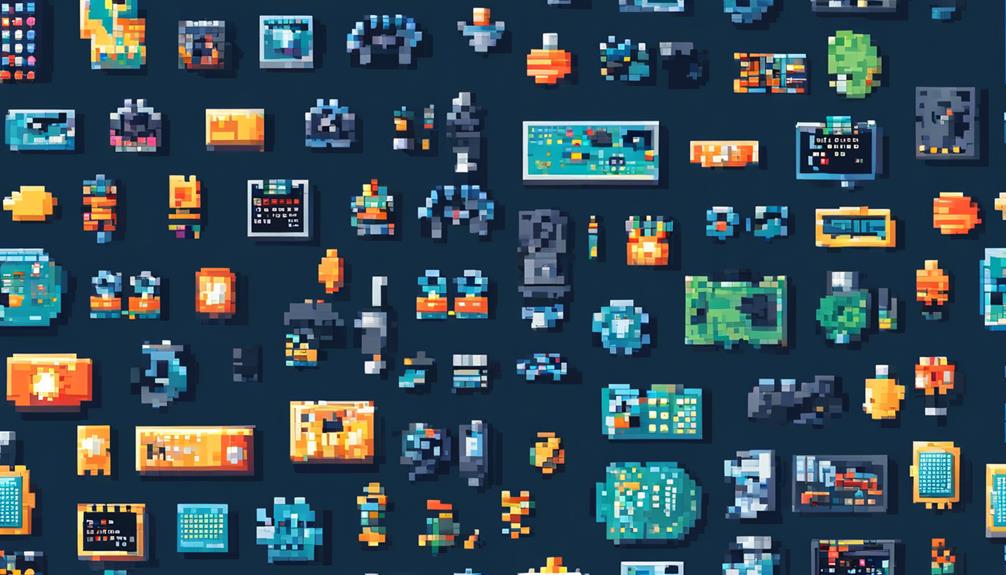
Controllers are essential components of IoT devices that manage and coordinate the functions of connected sensors and actuators, enabling seamless communication and automation within IoT systems. These devices play a crucial role in decision-making and automation within IoT systems.
Controllers process the data collected by sensors and initiate actions through actuators based on predefined rules or user commands. They often have built-in intelligence to interpret data and execute actions without constant human intervention.
Controllers are responsible for receiving, analyzing, and processing data from sensors. They interpret this data to make informed decisions and take appropriate actions. By monitoring the data collected by sensors, controllers can detect patterns, anomalies, and trends, allowing for proactive responses to changing conditions.
In addition to data processing, controllers also facilitate communication between various components of an IoT device or system. They act as intermediaries, ensuring that information flows smoothly between sensors, actuators, and other connected devices. This seamless communication enables real-time monitoring, control, and optimization of IoT systems.
Furthermore, controllers enable automation within IoT systems. They can be programmed to execute actions based on predefined rules or user commands. For example, a controller in a smart home system can automatically adjust the temperature based on the readings from temperature sensors, or a controller in an industrial setting can initiate maintenance actions when certain thresholds are met.
Data Processing Units
Data processing units in IoT devices utilize algorithms and software to analyze the data collected by sensors and actuators, playing a pivotal role in extracting meaningful insights and enabling informed decision-making within IoT systems.
Here are three key components of data processing units in IoT devices:
- Algorithmic Analysis: Data processing units employ advanced algorithms to analyze the collected data. These algorithms are designed to identify patterns, trends, and anomalies in the data, allowing for a deeper understanding of the underlying information. By processing the data in real-time, these units can provide immediate feedback and enable timely actions.
- Data Transformation: Raw data collected by sensors and actuators is often unstructured and requires transformation to be meaningful. Data processing units are responsible for transforming this raw data into actionable information. Through various techniques such as filtering, aggregation, and normalization, these units ensure that the processed data is accurate and consistent.
- Insights Generation: Once the data is processed and analyzed, data processing units generate meaningful insights. These insights provide valuable information that can be used to make informed decisions within IoT systems. Whether it is predicting equipment failure, optimizing energy consumption, or improving operational efficiency, these insights enable organizations to take proactive actions and enhance overall system performance.
Communication Protocols

Communication protocols play a crucial role in governing the rules and conventions for seamless and standardized data exchange between IoT devices and systems. These protocols ensure that different devices and platforms can communicate effectively, enabling the smooth flow of data. There are several common communication protocols used in IoT, including MQTT (Message Queuing Telemetry Transport), CoAP (Constrained Application Protocol), HTTP (Hypertext Transfer Protocol), and AMQP (Advanced Message Queuing Protocol).
These communication protocols determine various factors related to data exchange. One important aspect is the format in which the data is transmitted. Protocols like MQTT and CoAP use lightweight binary formats, which are highly efficient for IoT devices with limited resources. On the other hand, protocols like HTTP and AMQP support more complex data formats, making them suitable for use cases that require more advanced data handling capabilities.
Error handling is another critical factor managed by communication protocols. These protocols define the mechanisms for detecting and resolving errors that may occur during data exchange. They ensure that data integrity is maintained and that any errors are properly handled, minimizing the risk of data loss or corruption.
Furthermore, communication protocols also determine the structure of the messages exchanged between IoT devices and systems. They define the rules for packaging and organizing data, facilitating efficient communication. This includes aspects such as message headers, payloads, and metadata.
When choosing a communication protocol for IoT applications, various factors need to be considered. Power consumption, bandwidth requirements, and message size are among the key factors that impact the choice of protocol. It is important to select a protocol that aligns with the specific needs of the IoT deployment to optimize performance and resource utilization.
Power Supply
Power supply is a critical element in IoT devices, as it provides the necessary electrical energy for their operation, ensuring longevity and reliability. When it comes to powering IoT devices, there are several key components and considerations to keep in mind:
- Batteries: Many IoT devices rely on batteries as their power source. These batteries can be rechargeable or non-rechargeable, depending on the specific requirements of the device. Battery capacity and lifespan are important factors to consider, as IoT devices are often deployed in remote or hard-to-reach locations, making frequent battery replacement difficult.
- Energy Harvesting Modules: Energy harvesting modules allow IoT devices to capture and convert energy from the surrounding environment, such as solar power, thermal energy, or vibrations. These modules can provide a sustainable source of power for IoT devices, reducing the need for frequent battery replacements. However, the availability and consistency of the energy source must be carefully evaluated to ensure reliable operation.
- Direct Connection to a Power Source: In some cases, IoT devices can be directly connected to a power source, such as an electrical outlet or a power-over-Ethernet (PoE) connection. This eliminates the need for batteries or energy harvesting modules, providing a constant and reliable power supply. However, this approach may limit the mobility and flexibility of the IoT device.
Efficient power supply design is crucial for the longevity and reliability of IoT devices. IoT devices often require low power consumption to enable prolonged operation, as they are typically deployed in remote or inaccessible locations. Power supply optimization is essential to ensure that the device can operate for extended periods without the need for frequent maintenance or battery replacements.
Moreover, the power supply design influences the overall size, cost, and portability of IoT devices, making it a critical aspect of their development. By carefully considering the power supply requirements and options, IoT devices can be powered effectively, enabling the seamless functionality of sensors and actuators.
Security Mechanisms
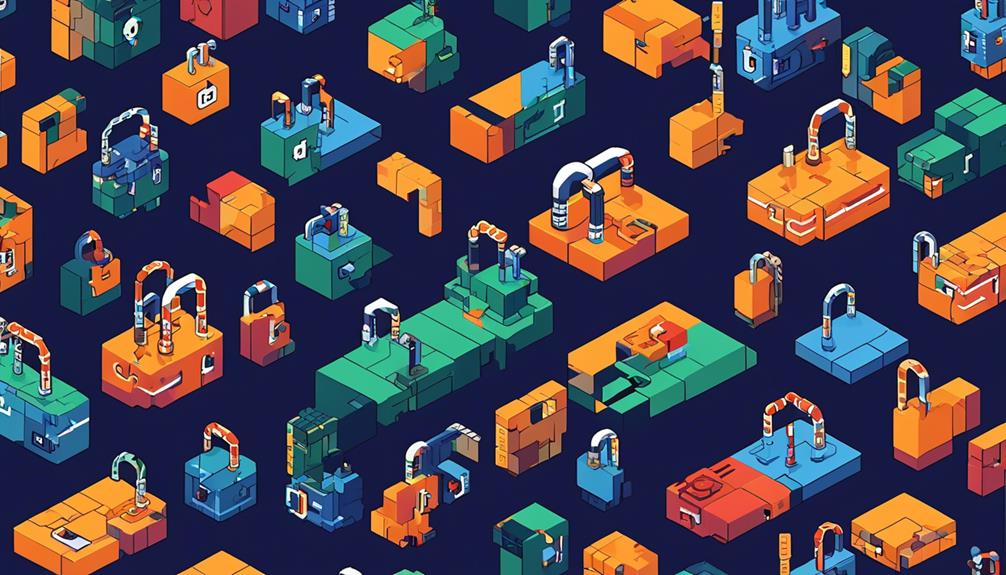
Security mechanisms are crucial components in IoT devices, providing encryption, authentication, and access control to protect against cyber threats and ensure the privacy and integrity of collected data.
Encryption plays a vital role in securing data transmitted between IoT devices and the cloud. It ensures that the data is encrypted, making it unreadable to unauthorized individuals or hackers who may attempt to intercept or tamper with the information. By using encryption, IoT devices can securely communicate with each other and with the cloud, minimizing the risk of data breaches.
Authentication mechanisms are another key component of IoT device security. These mechanisms verify the identity of both IoT devices and users before granting them access to the system. By implementing strong authentication protocols, IoT systems can prevent unauthorized access and protect sensitive data from being compromised.
Access control mechanisms are also essential in IoT devices to limit the actions and data that different devices and users can access. By implementing access control measures, IoT systems can ensure that only authorized devices and users have access to specific resources or functionalities. This reduces the risk of security breaches and unauthorized modifications to the system.
Firmware and Software
Firmware and software play integral roles in the functionality and intelligence of IoT devices, enabling them to collect, process, and transmit data while interacting with users and other devices. Here are three key components of firmware and software in IoT devices:
- Firmware:
Firmware is a type of software that is embedded into the hardware of an IoT device. It provides low-level control for the device's specific hardware components, allowing them to function according to the desired specifications. Firmware acts as the bridge between the hardware and higher-level software, ensuring smooth operation and efficient utilization of resources.
- Software Applications:
IoT devices rely on various software applications to provide higher-level functionality. These applications can include user interfaces, data processing algorithms, and communication protocols. Software applications enable users to interact with IoT devices, access collected data, and perform actions based on the analyzed data. They also facilitate seamless integration with other devices and platforms, expanding the capabilities and possibilities of IoT systems.
- Operating Systems:
IoT devices often require operating systems to manage and coordinate different software components. These operating systems provide a platform for hosting and running applications, managing resources, and ensuring security. Operating systems designed for IoT devices are often lightweight and optimized for resource-constrained environments. They enable efficient execution of software, reliable data management, and secure communication.
Firmware and software in IoT devices are continuously updated and improved to enhance performance, security, and capabilities. Regular updates ensure that devices stay secure against evolving threats, and new features and optimizations are introduced to meet changing user requirements. The firmware and software components work together to enable IoT devices to collect data, process it through software applications, and transmit the analyzed data to other devices or cloud platforms.
Cloud Infrastructure
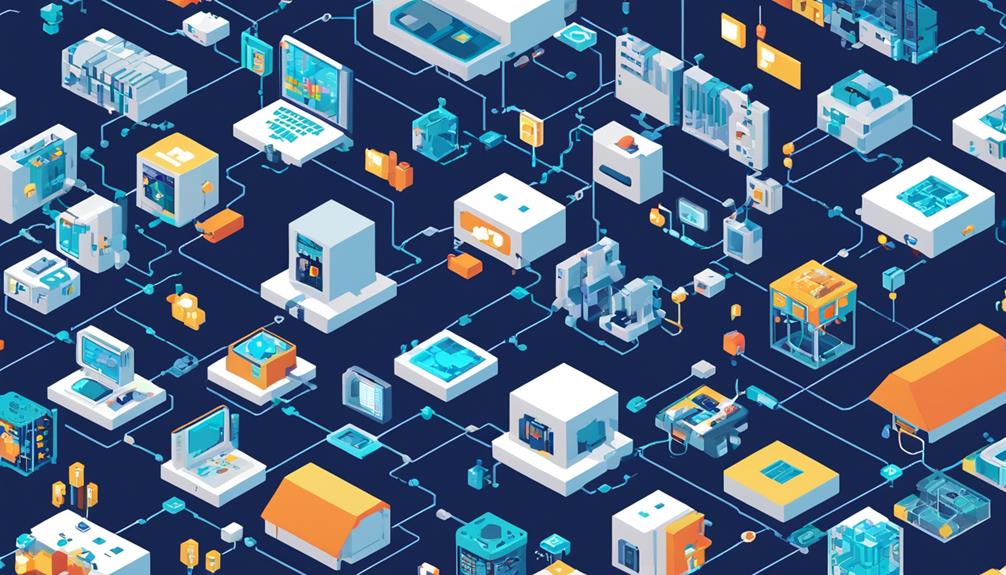
Cloud infrastructure is a crucial component of IoT devices. It provides the necessary scalability to handle large volumes of data generated by these devices.
It also offers secure and reliable data storage, ensuring the protection and accessibility of IoT data.
Additionally, cloud infrastructure enables real-time analytics and machine learning capabilities. This empowers organizations to extract valuable insights from IoT data to make informed decisions.
Scalability in Cloud
The ability of a cloud infrastructure to seamlessly handle increasing workloads and accommodate a larger number of IoT devices and data traffic is known as scalability in the cloud. Scalability is a critical aspect of cloud infrastructure for IoT applications. Here are three key components of scalability in the cloud:
- Load balancing:
Scalability in cloud infrastructure is achieved through load balancing, which evenly distributes the workload across multiple servers. This ensures that no single server is overwhelmed, leading to improved performance and reliability.
- Auto-scaling:
Cloud scalability allows for the automatic addition or removal of computing resources based on demand. When the workload increases, the cloud infrastructure automatically provisions additional resources to maintain optimal performance. Conversely, when the demand decreases, resources are scaled down to avoid unnecessary costs.
- Scalable storage and computing resources:
The cloud infrastructure must provide scalable storage and computing resources to accommodate the growing volume of data generated by IoT devices. This ensures that the system can handle the increasing data traffic without any degradation in performance.
Data Storage and Security
Data storage and security in cloud infrastructure for IoT devices is a critical component that ensures the protection, reliability, and scalability of the massive amounts of collected data.
Cloud infrastructure provides a solution for the storage of data collected by IoT devices, offering secure and reliable storage capabilities. To safeguard the stored data, various encryption and authentication methods are implemented, preventing unauthorized access and loss.
Cloud infrastructure also enables real-time data analysis and processing, facilitating informed decision-making. Additionally, it offers scalability, allowing IoT systems to efficiently handle increasing data volumes.
User Interfaces
Facilitating human interaction and control, user interfaces are integral components of IoT devices that offer a visually appealing and interactive means for users to monitor, manage, and extract valuable insights from the generated data.
Here are three key aspects of user interfaces in IoT systems:
- Multiple Interface Options: User interfaces in IoT devices can take various forms, including mobile apps, web interfaces, touchscreens, voice commands, and other interactive methods. This allows users to choose the interface that best suits their preferences and needs. For example, a mobile app might provide a convenient way to control and monitor IoT devices remotely, while a touchscreen interface on a smart home hub may offer a central control panel for managing multiple IoT devices within a home.
- Design and Usability: The design of user interfaces in IoT devices is crucial for ensuring ease of use, accessibility, and a positive user experience. Clear and intuitive interfaces with well-organized features and controls enable users to easily navigate and interact with the IoT system. The use of visual cues, icons, and color schemes can enhance user understanding and engagement. Additionally, responsive design principles should be applied to ensure that the user interface adapts seamlessly to different screen sizes and resolutions.
- Alerts, Notifications, and Insights: User interfaces play a key role in enabling users to receive alerts, notifications, and insights from the IoT system. For example, a user interface may display real-time data analytics, such as temperature or energy consumption, and provide notifications when certain thresholds are exceeded. Users can then take proactive actions based on these insights, such as adjusting settings or receiving recommendations for optimizing energy usage.
Integration Capabilities
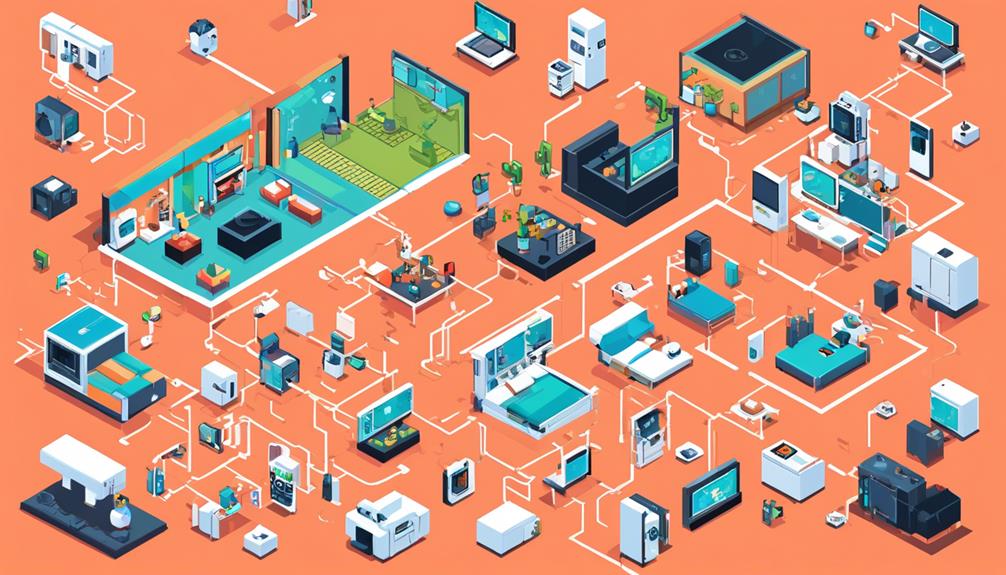
Integration capabilities are an essential aspect of IoT devices, enabling them to seamlessly connect and communicate with other devices and systems. One key point to consider is the availability of seamless connectivity options, which allow IoT devices to easily establish connections with various technologies and platforms.
Additionally, integration capabilities offer data integration possibilities, enabling the sharing and exchange of data between different devices and systems.
Another important aspect is device interoperability solutions, which ensure that IoT devices can work together efficiently, regardless of their differences in technology or protocols.
Seamless Connectivity Options
Seamless connectivity options, essential for effective communication among IoT devices and centralized systems, encompass a range of technologies with unique tradeoffs in power consumption, range, and bandwidth. These options include:
- WiFi: This technology allows IoT devices to connect to the internet and transmit data wirelessly over short to medium distances. It offers high bandwidth but consumes more power compared to other options.
- Bluetooth: Ideal for short-range communication, Bluetooth enables IoT devices to connect and exchange data with each other. It has low power consumption and is commonly used in applications like home automation.
- Cellular: With wide coverage and high reliability, cellular networks enable IoT devices to connect to the internet from anywhere. They offer good bandwidth but may consume more power and incur data costs.
These connectivity options play a crucial role in collecting data from IoT devices and connecting them to centralized systems for analysis and decision-making. By providing seamless integration capabilities, they ensure efficient and effective communication between devices and enable the smooth functioning of IoT systems.
Data Integration Possibilities
Building upon the seamless connectivity options discussed previously, the integration capabilities of IoT devices play a crucial role in enabling the seamless combination and comprehensive analysis of data from multiple sources.
These integration possibilities allow IoT devices to incorporate data from smart sensors and external systems, ensuring interoperability and enabling the aggregation of data from diverse sources.
By incorporating data from various formats and protocols, IoT devices can facilitate the convergence of information from different IoT devices and platforms, providing a holistic view of the overall IoT ecosystem.
Additionally, the integration potential of IoT devices enables the sharing and exchange of data with other devices, systems, and applications, fostering collaboration and synergy in the IoT environment.
With these capabilities, IoT devices can aggregate and consolidate data, providing a unified and coherent view of the information collected from the environment.
Device Interoperability Solutions
Device interoperability solutions are essential in enabling different IoT devices to seamlessly communicate and collaborate with one another. These solutions play a crucial role in creating a cohesive and interconnected IoT ecosystem.
Here are three key components of device interoperability solutions:
- Integration capabilities: Integration capabilities in IoT devices allow them to connect with various protocols and platforms. This ensures that IoT devices from different manufacturers can collaborate and share data effectively. By supporting diverse communication standards and technologies, integration capabilities enable devices to work together seamlessly.
- Protocol translation: Device interoperability solutions often involve protocol translation, which allows devices using different communication protocols to understand and exchange information. This enables devices with different protocols to communicate and cooperate, regardless of their differences.
- Platform integration: Device interoperability solutions also include platform integration, enabling devices to connect and interact with different IoT platforms. This integration ensures that devices can seamlessly share data and interact with other devices and systems within the IoT ecosystem.
Frequently Asked Questions
What Are the Major Components of Iot Devices?
The major components of IoT devices include:
- Sensors and actuators
- Connectivity technology
- Data processing mechanisms
- User interfaces for interaction and control
These components are crucial for the functioning of IoT devices and enable:
- The collection, transmission, analysis, and user interaction with data
The architecture of IoT devices is designed to incorporate these components seamlessly, allowing for:
- Efficient data collection, processing, and communication
Additionally, the connectivity technology plays a vital role in:
- Establishing a reliable and secure connection between the IoT device and the cloud or data storage location.
What Do Devices in Iot Include?
Devices in IoT include a wide range of physical objects, such as cars, appliances, and medical devices. These devices are interconnected through various connectivity technologies, allowing them to communicate with each other and external systems.
They are equipped with sensors that enable data collection from the environment, as well as actuators for executing actions based on the collected data. This connectivity and data collection capability forms the foundation of IoT devices, enabling them to gather and transmit real-world data for analysis and decision-making.
Which of the Following Is a Key Component of Iot Ecosystems?
Smart sensors are a key component of IoT ecosystems. These sensors collect real-time data from the environment, enabling the monitoring and measurement of various parameters. They play a crucial role in capturing data that forms the foundation for IoT applications.
Additionally, cloud connectivity is another vital component. It allows for seamless transmission and storage of data, enabling remote access and analysis.
Together, smart sensors and cloud connectivity form the backbone of IoT systems, enabling efficient and intelligent data-driven decision-making.
What Is the Key Element of Iot Security?
The key element of IoT security is ensuring the protection of data and devices within the IoT ecosystem. This involves implementing robust encryption and authentication mechanisms to ensure data privacy and device authenticity.
Additionally, secure firmware and software updates are essential to patch vulnerabilities and prevent security flaws.
Access control and authorization play a crucial role in managing user permissions and system access.
Monitoring and intrusion detection systems help identify and respond to security breaches, while secure communication protocols safeguard data transmission between devices and the cloud.
